That's 郷土玩具, kyoudo gangu if you're surfing at home. [that Google link will survive the posting process, even if the characters get mangled.]
After seeing that beautiful suite of woodblock prints of Meiji-era Japanese toys [late 19th - early 20th c.] on BibliOdyssey, I started asking around to see who makes these things today. The first person I thought to ask was someone who has immersed himself in a venerable Japanese traditional art form in order to create thoroughly modern, awesome work: Takeji Nakagawa of Take-g Toys. Takeji provided an incredible list of links and resources, most of which, unfortunately, are only in Japanese. Still, clicking around a few of them is well worth the effort. And I'll post some highlights below.
Like cuisine, onsen/hot springs, and many crafts, kyoudo gangu are part of a layer of Japanese culture that is very self-consciously regional. A lot of them are linked somehow to local shrines and temples. Here are a couple of collections:
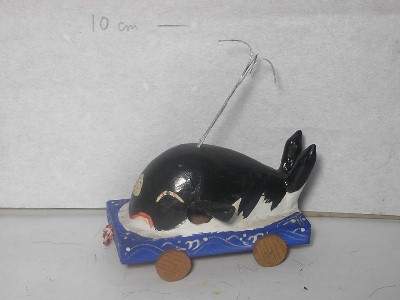
KZCori has mapped the gangu collection his late father made while traveling Japan as a literature professor. The tchotchke factor is kind of high, but there are a few playable-looking toys, too. The whale above is from around Nagasaki. [kzcori.com]
Popyah has been making the same rounds, only with a focus on contemporary folk-style toys made within the last fifteen years or so. Popyah seems to gravitate towards tsuchi ningyo, painted clay/ceramic figurines which, while cute and/or beautiful, are not exactly ideal toys for little kids. Several are called hineri; not sure what that's about. The dolls from the Momotaro story above are from Okayama. [popyah]
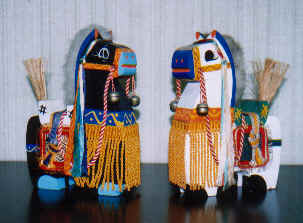
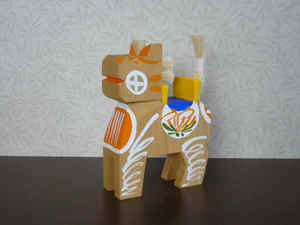
Here's a collection of horses, which has some examples close to the awesomeness of the carved wooden horses in the woodblock prints. The pair on the left are from Morioka, Take-g's hometown, actually; I think they're called Chaguchagu Uma-go. The one on the right is from Sendai. [umazanmai]
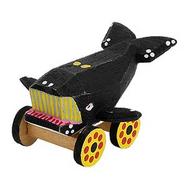
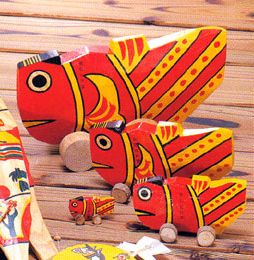
This regional focus means that to buy these gangu, you have travel to the spots they're made, like getting bear-shaped cookie jars at Yellowstone. There's not a lot readily available online, and what is online tends to be kind of uncompelling.
These koi nobori/carp flag-shaped pulltoys are from Hitoyoshi, the Kyoto of Kyushu.
The carved whale-on-wheels [above, l] would be a great pulltoy if it were any bigger than 8cm. [It's by miniatures artist 森音広夢, Morioto Hiroyume (?) so whatryagonnado?] The 鯛車, taiguruma--or, what, snapper wagon?--[above, r] is definitely available in various sizes, and should be on your list if you're in Kagoshima. [Anyone who knows what the old Japanese saying, 「鯛車の復活を夢見る仲間」"Friends dreaming of the return of the snapper wagon"? means, feel free to chime in. Is it a reference to the little tai-shaped donuts filled with bean paste which only appeared at festival time, perhaps?]
Finally--for the moment, because this is taking way too long to translate and type and learn all at the same time--another stop on any kyoudo gangu tour has to be in Kurashiki, a city in the southwestern prefecture of Okayama. That's the site of the Gangukan, the Folk Toy Museum. It's promising to see on the map that the shop and the commercial Plus One gallery are as big as the historical exhibition galleries. Still, the site's pretty sparse on details of either the collection or the goods.
There's a ton more info out there, but I've skewed toward the little kid-friendliest end of the spectrum. Those whales and horses should keep the woodcarving dads busy for a little while. Meanwhile, I'll keep digging, and if anyone has any tips or finds, feel free to share them. Thanks again to Takeji for his expertise and info.
Previously: Awesome Old Old Japanese Toys
Stunning Wood Toys by Take-G

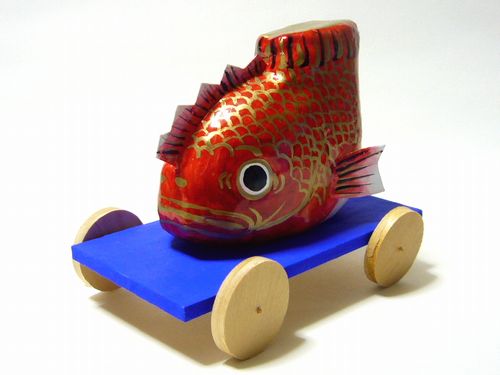
Wow. Very cool. I'll have to put together a list of villages to hit for when we visit the in-laws Kobe next year. Love the whale, especially.